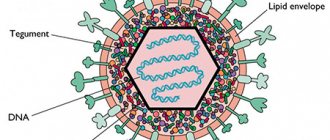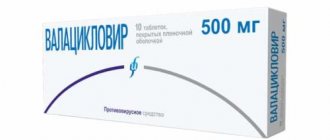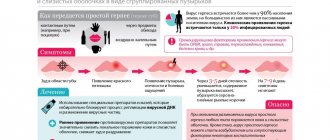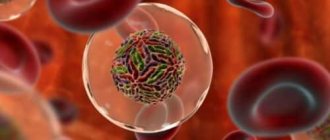STD
Almost the entire population of the globe is infected with herpes simplex viruses types 1 and 2. Almost everyone is familiar with the first type - colds on the lips.
Infection occurs in early childhood. But for obvious reasons, it is not customary to talk about herpes simplex virus type 2 - genital.
However, this infection is far from unique, and how people become infected with herpes that affects the genitals is of interest to a large number of people. According to WHO statistics, in 2021, almost 500 million consulted doctors with problems caused by herpetic eruptions in the external genital area.
Treatment of genital herpesvirus is more effective under the supervision of a specialist
The most popular questions on the network that relate to this topic will be answered by a venereologist of the highest category, head of the skin and venereal disease clinic, Viktor Ivanovich Likhodeev (pictured above).
- What is herpes and how is it transmitted
- Genital herpes - period of contagiousness
- How to avoid getting infected with herpes type 2
Herpes simplex virus type 1 (HSV-1)
HSV-1 is a highly contagious infection that is widespread and endemic throughout the world. Most cases of HSV-1 infection occur during childhood and the infection remains lifelong. The vast majority of cases of HSV-1 infection result in oral herpes (an infection in or around the mouth, sometimes called orolabial or orofacial herpes), but in some cases HSV-1 also causes genital herpes (infections in the genital or anal area).
Scale of the problem
In 2021, an estimated 3.7 billion people under age 50, or 67% of the world's population, were infected with HSV-1 (had oral or genital herpes). Prevalence rates were estimated to be highest in Africa (88%) and lowest in the Americas (45%).
Most HSV-1 infections were oral infections. In 2021, an estimated 122 million to 192 million people aged 15–49 years worldwide had genital HSV-1 infections, but prevalence varied widely across regions. The largest number of cases of genital HSV-1 infection are estimated to occur in the Region of the Americas, European and Western Pacific Regions, where HSV-1 infection continues into adulthood.
Signs and symptoms
Oral herpes infections are usually asymptomatic, and most people infected with HSV-1 are unaware that they are infected. Symptoms of oral herpes include painful blisters or open lesions called sores in or around the mouth. Lesions on the lips are commonly referred to as "fever". Before the lesions appear, infected individuals often experience tingling, itching, or burning in the mouth area. After the initial infection, blisters or sores may recur periodically. The frequency of their occurrence varies from person to person.
Genital herpes caused by HSV-1 can be asymptomatic or cause mild symptoms that go unrecognized. When symptoms do appear, genital herpes is characterized by the appearance of one or more blisters or sores in the genital or anal area. After an initial episode of genital herpes, which can be severe, symptoms may recur. However, genital herpes caused by HSV-1 typically does not recur frequently, unlike genital herpes caused by herpes simplex virus type 2 (HSV-2; see below).
Transmission of infection
HSV-1 is transmitted primarily through oral contact and causes oral herpes infections due to contact with HSV-1 in lesions, saliva, and surfaces in or around the mouth. However, due to oral-genital contact, HSV-1 can also spread to the genital area and cause genital herpes.
HSV-1 can be transmitted through the surface of the mouth or skin that appears normal and has no symptoms. However, the greatest risk of transmission occurs when active lesions are present.
In individuals who already have an oral herpes infection, subsequent infection of the genital area with HSV-1 is unlikely.
In rare cases, HSV-1 infection can be passed from a mother with genital HSV-1 infection to her baby during birth and lead to neonatal herpes (see below).
Possible complications
Severe form of the disease
In people with weak immune systems, such as people with advanced HIV infection, HSV-1 can cause more severe symptoms and more frequent relapses. In rare cases, HSV-1 infection can also lead to more severe complications such as encephalitis (brain infection) or keratitis (eye infection).
Neonatal herpes
The development of neonatal herpes can occur when a newborn comes into contact with HSV in the genital tract during childbirth. Neonatal herpes occurs rarely, estimated to occur in 10 out of every 100,000 births worldwide, but this severe condition can lead to permanent neurological disability or death. Women who have had genital herpes before pregnancy have an extremely low risk of transmitting HSV to their children. The greatest risk of neonatal herpes occurs when a woman is first infected with HSV late in pregnancy, in part because the highest concentrations of HSV in the genital tract occur early in the infection.
Psychosocial impact
The recurrence of oral herpes symptoms can be uncomfortable and lead to some social stigma and psychological distress. In genital herpes, these factors can have a significant adverse impact on quality of life and sexual relationships. However, over time, most people with some form of herpes adjust to living with the infection.
Treatment
The most effective medications for people infected with HSV are antiviral drugs such as acyclovir, famciclovir and valacyclovir. They help relieve symptoms and reduce the frequency of their occurrence, but do not lead to a complete cure.
- WHO guidelines for the treatment of genital infections caused by herpes simplex virus
Prevention
HSV-1 is most contagious when oral herpes symptoms appear, but it can also be transmitted when no symptoms are felt or observed. Individuals with active symptoms of oral herpes should avoid oral contact with others and sharing objects that have come into contact with saliva. They should also abstain from oral sex to prevent herpes from spreading to their partner's genitals. People with symptoms of genital herpes should avoid sexual intercourse while they are experiencing symptoms.
Consistent and correct use of condoms can help prevent the spread of genital herpes. However, condoms can only reduce the risk of infection, since symptoms of genital herpes can appear in areas not protected by a condom.
Individuals already infected with HSV-1 cannot become infected again, but they remain at risk of infection with HSV-2, which affects the genital area (see below).
Pregnant women with symptoms of genital herpes should inform health care providers. Preventing new infections with genital herpes virus is especially important for women in late pregnancy, since this is the period when the risk of developing neonatal herpes is highest.
More research is being conducted to develop more effective methods of preventing HSV infections, such as vaccines. A number of vaccine candidates against HSV are currently being studied.
At-risk groups
The causative agent of the disease, after initial penetration into the body, remains dormant in the nerve cells that are located in the spinal ganglia. Is it possible to get infected again? No, the body develops lasting, lifelong immunity. When the immune system is suppressed, the virus can move from the latent stage to the active phase, which leads to an exacerbation of the disease.
Relapse of the disease, like primary infection, occurs in 3 stages:
- prodromal period - duration 1-3 days, accompanied by a deterioration in general condition, increased body temperature, discomfort in the body area, where a rash later appears;
- the rash period lasts 3-5 days, accompanied by the appearance of a small vesicular rash with transparent contents; after the vesicles open, painful ulcers form;
- The recovery period lasts 2-3 days; brown crusts form at the site of the ulcers, which fall off without scarring.
The likelihood of becoming infected from a sick person is high during the period of formation of a herpetic rash. How many days is herpes contagious? During the period of rash until crusts form. The serous fluid of the vesicles contains a large number of viruses that can infect a healthy person. The pathogen persists for a long time in the external environment and is resistant to water and ultraviolet radiation. This increases the risk of infection.
Is herpes contagious if a person is a carrier without clinical signs of the disease? Scientists have proven that even during the latent phase of infection, the virus can be present in the carrier’s biological fluids (vaginal discharge, saliva, tears, blood, urine). Upon contact, the virus can enter the skin and enter a healthy body through microtraumas. However, this method of transmission of infection is less likely than infection during the active phase of the disease.
A strong immune system keeps the virus under control. Herpes is contagious when the body's defenses are reduced or the immune system is suppressed.
Risk groups for infection and transmission of infection:
- colds, ARVI;
- hypothermia, overheating;
- menstruation;
- injuries;
- exacerbation of chronic diseases;
- stressful situations;
- oncology;
- vitamin deficiencies;
- immunodeficiencies;
- taking immunosuppressive therapy (cytostatics, chemotherapy).
Is herpes transmitted if a person has a healthy immune system? In most cases, no, but when the defenses are reduced, the pathogen easily penetrates the body. The methods of transmission of herpes can be different, but most often through household and contact.
Herpes simplex virus type 2 (HSV-2)
HSV-2 infection, which causes genital herpes, is widespread throughout the world and is transmitted almost exclusively through sexual contact. HSV-2 is the main cause of genital herpes, although it can also be caused by herpes simplex virus type 1 (HSV-1). HSV-2 infection is lifelong and cannot be cured.
Scale of the problem
Genital herpes caused by HSV-2 is a global problem, with an estimated 491 million people (13%) aged 15–49 years worldwide having the infection in 2021.
More women than men are infected with HSV-2; In 2021, an estimated 313 million women and 178 million men were living with the infection. This is because HSV is transmitted sexually more efficiently from a man to a woman than from a woman to a man.
Prevalence of HSV-2 infection is estimated to be highest in Africa (44% in women and 25% in men), followed by the Americas (24% in women and 12% in men). The prevalence of infection increases with age, although the largest number of newly infected individuals are adolescents.
Signs and symptoms
Genital herpes infection is often asymptomatic or with mild symptoms that go unrecognized. Most infected people do not know they are infected. Typically, about 10-20% of individuals infected with HSV-2 report a previous diagnosis of genital herpes. However, clinical studies that closely monitor cases of initial infection have demonstrated that up to one third of newly infected people may have symptoms.
When symptoms do appear, genital herpes is characterized by the appearance of one or more blisters or open lesions called sores on the genital or anal area. In addition to genital ulcers, symptoms of primary genital herpes infection often include fever, body aches, and swollen lymph nodes.
After an initial episode of herpes infection of the genital area caused by HSV-2, it is not uncommon for symptoms to reappear, but they are less intense than when they first appeared. The frequency of symptoms usually decreases over time, but they may persist for many years. Before genital sores appear, people infected with HSV-2 may experience mild tingling or shooting pain in their legs, thighs, and buttocks.
Transmission of infection
HSV-2 is transmitted mainly through sexual intercourse, contact with genital surfaces, skin, affected areas or fluids of a person infected with this virus. HSV-2 can be transmitted through the skin of the genital or anal area, which appears normal, and is often transmitted even in the absence of symptoms.
In rare cases, HSV-2 infection can be passed from mother to child during birth and cause neonatal herpes (see below).
Possible complications
HSV-2 and HIV
It has been proven that HSV-2 and HIV influence each other. Infection with HSV-2 increases the risk of HIV infection by approximately three times. In addition, people infected with HIV and HSV-2 are more likely to transmit HIV to others. HSV-2 is one of the most common infections among people living with HIV infection, occurring in 60-90% of people with HIV infection.
HSV-2 infection in people living with HIV infection (and other immunocompromised people) is often more severe and has more frequent recurrences. In later stages of HIV infection, HSV-2 can lead to more severe, although rare, complications such as meningoencephalitis, esophagitis, hepatitis, pneumonitis, retinal necrosis, or disseminated infection.
Neonatal herpes
The development of neonatal herpes can occur when a newborn comes into contact with HSV (HSV-2 or HSV-1) in the genital tract during childbirth. Neonatal herpes occurs rarely, estimated to occur in 10 out of every 100,000 births worldwide, but this severe condition can lead to permanent neurological disability or death. Women who have had genital herpes before pregnancy have an extremely low risk of transmitting HSV to their children. The greatest risk of neonatal herpes occurs when a woman is first infected with HSV late in pregnancy, in part because the highest concentrations of HSV in the genital tract occur early in the infection.
Psychosocial impact
Recurrences of genital herpes symptoms can be painful, and the infection can lead to social stigma and psychological distress. These factors can have a significant adverse impact on quality of life and sexual relationships. However, over time, most people with herpes adjust to living with the infection.
Treatment
The most effective medications for people infected with HSV are antiviral drugs such as acyclovir, famciclovir and valacyclovir. They help relieve symptoms and reduce the frequency of their occurrence, but do not lead to a complete cure.
- WHO guidelines for the treatment of genital infections caused by herpes simplex virus
Prevention
People with a genital infection caused by HSV should abstain from sexual activity while symptoms of genital herpes appear. HSV-2 is most contagious when lesions appear, but it can also be transmitted when no symptoms are felt or observed.
Systematic and correct use of condoms can help reduce the risk of spreading genital herpes. However, condoms provide only partial protection because HSV can be found in areas not protected by a condom. Medical male circumcision can provide men with lifelong partial protection against HSV-2, as well as HIV and human papillomavirus (HPV).
Individuals with symptoms suggestive of genital HSV infection should be tested for HIV infection, and those living in areas with high HIV prevalence should be offered more focused HIV prevention interventions, such as pre-exposure prophylaxis.
Pregnant women with symptoms of genital herpes should inform health care providers. Preventing new infections with genital herpes virus is especially important for women in late pregnancy, since this is the period when the risk of developing neonatal herpes is highest.
More research is being conducted to develop more effective methods of preventing HSV infections, such as vaccines or topical germicides (drugs to protect against sexually transmitted infections that can be used intravaginally or intrarectally).
How can you protect yourself?
Prevention of herpes infection is possible through nonspecific and specific prophylaxis or vaccination.
The implementation of nonspecific prevention measures requires compliance with the following rules:
- It is important to try to avoid direct contact with a sick person. You cannot kiss him, have sex, share dishes, bath accessories, or household items.
- If a sick person detects characteristic symptoms, he should seek medical help and treat the herpetic infection. He must understand that he is a direct threat to other people during the period until the rashes on the skin or mucous membranes crust over. Wearing a cotton-gauze bandage will help protect his close relatives.
- Treatment involves treating the rash. In order to avoid direct contact with clean skin, it is important to use cotton pads or cotton swabs during local treatment. And after treatment, wash your hands thoroughly with soap and treat them with liquid antiseptic. This measure will prevent the possibility of infecting others through contact.
- To prevent a relapse of the disease, it is necessary to provide the body with adequate nutrition, good physical activity, harden yourself and give up bad habits.
Careful adherence to personal hygiene rules will help prevent infection with herpes through contact and household contact. If there is a sick person in the house, it is useful to wash door handles once a day, wipe all surfaces of objects with antiseptic solutions, and do wet cleaning in the apartment.
WHO activities in the field of herpes control (HSV-1 and HSV-2)
Globally, there is a need to increase awareness of HSV infection and its symptoms, improve access to antivirals, and intensify efforts to prevent HIV infection among people with symptoms of genital HSV infection.
In addition, improved treatment and prevention measures, in particular vaccines against HSV, need to be developed. WHO and partners are working to accelerate research to develop new strategies for the prevention and control of genital and neonatal infections caused by HSV-1 and HSV-2. This research includes the development of HSV vaccines and topical bactericides. A number of vaccine candidates and microbicides are currently being studied.
Transmission of herpes infection from mother to child
In this case, it is important to distinguish between two ways of infection with herpes - if the mother is initially infected even before pregnancy, and when the pregnant woman becomes a carrier of pathogenic flora already during pregnancy. In the first case, the threat to intrauterine development is less significant, and in the second, doctors may recommend an abortion. It is necessary to study in more detail all possible clinical pictures:
- If the microbe predominated in a woman’s life even before pregnancy, the consequences for the intrauterine development of the fetus are not so significant. However, this does not mean at all that pathology can be triggered; the main thing is to be selective about the prescribed drug therapy, follow all medical recommendations, and carry out supportive therapy.
- If HSV-1 progresses before the 20th obstetric week, the risk of infection of the fetus is minimal, and the consequences for child health are also minimal. Treatment is carried out using conservative methods in the relapse stage; in other clinical situations, the doctor recommends observational therapy. The main thing is that pathogenic flora is not transmitted to the fetus.
- If HSV-1 appears in a woman’s body in the third trimester of pregnancy, there is a 50% chance of infection of the fetus. The consequences for the child are not the most favorable, since he is born with extensive pathologies. In addition, premature onset of labor is possible.
It only remains to add that the clinical outcome for mother and child depends entirely on the type of virus that has entered the pregnant body. If it is a simple virus of the first type, there is no need to fear for the health of the expectant mother and fetus in the first trimester, but if the chickenpox virus worsens, doctors strongly recommend an abortion early in the progressing pregnancy. Otherwise, the child may be born with extensive congenital diseases and receive the status of a disabled person from the first days of life.
Diagnostic methods
Treatment of herpes type 1 and 2 is carried out comprehensively, but, first of all, the doctor refers the patient to laboratory tests. Doctors take blood as biological material for research.
A blood test is performed to determine IgG to the herpes virus using two methods:
- ELISA is an analysis that allows you to study immunity for enzyme compounds.
- PCR is a polymerase type of chain reaction.
The difference between these methods is that ELISA allows you to determine the level of antibodies to the herpes virus types 1 and 2, PCR - the herpes virus itself in the blood, or more precisely, its DNA. Most often, doctors prescribe ELISA. It helps to detect the virus throughout the body, but PCR only helps to detect the virus in tissues taken for analysis.
When conducting a laboratory test using the ELISA method, if the indicators are “positive,” this will indicate the presence of IgG, IgA or IgM antibodies in the patient’s body. It is the latter that are immunoglobulins - antibodies produced by the immune system in the fight against infection.
In particular, the production of antibodies and the result for IgM are positive - this indicates the initial stage of the herpes infection. If IgA or IgG are diagnosed, such proteins are detected in the body after a month after infection with the herpes virus.
Decoding the results obtained
- A negative and negative titer was diagnosed - there is no infection with the virus, but there is no immunity.
- Negative and positive titer results - herpes is present in its opened form, immunity is formed, but if it weakens, the disease will manifest itself with negative symptoms.
- Positive/negative titer – primary infection has occurred, therefore urgent treatment is indicated. This is especially important if the test was taken by a woman planning a pregnancy - the moment of conception should be postponed during the course of treatment.
- The titer result is positive/positive - in this version of the results obtained, herpes does not develop in the chronic stage of its course, but during the period of exacerbation. Both antiviral and immunostimulating drugs are prescribed.
Important to remember! If a laboratory detects all 3 types of herpes infection - IgG, IgM or IgA, or the first two, this indicates a serious danger.
If viruses of the pathogenic microorganism herpes 1 IgG are detected, the infection is primary, therefore additional tests are prescribed to detect IgM. With a positive type of titer, the infection occurs in its acute or chronic stage.
If the indicators are negative, studies are carried out after some time. When IgG antibodies are detected in the blood, according to positive dynamics, the indicators indicate the following:
- the infection occurs in a chronic form; with positive dynamics of the disease, herpes will manifest itself with clinical signs in an acute form.
- Intrauterine infection is also possible.
If the results of laboratory tests are negative for the detection of IgG antibodies, the course of an acute form of injection is unlikely, and the patient does not have a chronic form of herpes types 1 and 2.
Carrying out analysis
ELISA as a laboratory analysis is carried out in 2 stages:
- The collected biomaterial is combined with the antigen. It is after this that the immune complex is monitored.
- A chromogen is added to the starting material, and the intensity of the staining can indicate the level of pathogenic microflora in the patient’s body.
Prevention of infection
Without detailed diagnostics of biological fluid, it is difficult to say which person is a carrier of a pathogenic virus and who was spared such an unpleasant fate. If alarming symptoms are completely absent, treating doctors still recommend taking basic preventive measures, which should become the norm of everyday life. To protect yourself from pathogenic flora and its destructive effects in the body, especially knowing how it is transmitted, you must adhere to the following preventive measures:
- It is necessary to carry out preventive vaccination using the drug Gerpevac for these purposes. Such an effective medicine helps rid 80% of all vaccinated people from the virus.
- It is necessary to regularly strengthen the immune system with natural vitamins and multivitamin complexes produced in pharmacies. In addition, moderate physical activity and cardio exercise will not be superfluous.
- It is necessary to regularly observe basic rules of personal hygiene, have a personal set of bed linen, a personal set of dishes, hygiene items, and it is important to avoid contact with already infected people in every possible way.
- During sexual intercourse (especially if you frequently change sexual partners), you must always use barrier methods of contraception. This is the best way to avoid genital herpes and its unpleasant symptoms in the life of an infected person. This is how herpes is transmitted, and the health consequences can be very unfavorable.
- If an infected person has visible symptoms of herpes on his face and body, it is advisable not to have contact with him: do not share underwear and household items, do not share your own dishes, and, especially, do not proceed to physical contact. Otherwise, after a few weeks, a once healthy person will develop similar symptoms on the body and mucous membranes.
It is important not only to know how herpes is transmitted, but also how it is dangerous for humans. For example, when entering a weakened body, the pathological process is not limited to the upper layer of the epidermis and mucous membrane. It penetrates deep into the soft tissues and can reach important bone marrow structures and nerve cells. In this case, the action of the immune system is powerless, a hidden danger to human health prevails, and the pathological process becomes irreversible.











